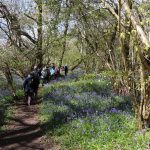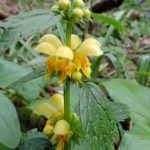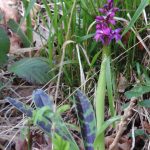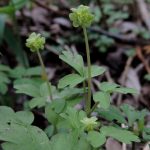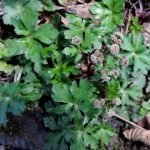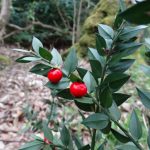After several weeks of cold weather it seemed to get a bit warmer, which brought out 26 walkers for a trip to Harefield Copse and Boxgrove Wood west of Tilehurst. The walk was led by Renée Grayer and started on a public footpath off Pincents Lane. Along the path Dove’s-foot Crane’s-bill (Geranium molle), Petty Spurge (Euphorbia peplus) and Garlic Mustard (Alliaria petiolata) were flowering. The footpath opened up to a field full of Bulbous Buttercup (Ranunculus bulbosus), which looks like Creeping Buttercup, but is distinguished by flowering earlier and having a swollen stem base and reflexed sepals. One specimen of the taller and more slender Meadow Buttercup (R. acris) was also present. In the hedgerow the starry yellow flowers of Lesser Celandine (Ficaria verna) were greeting us. Also in the hedgerow was Ground-ivy (Glechoma hederacea) with blue-purple flowers and both male and female plants of Dog’s Mercury (Mercurialis perennis), the female plants already in fruit.
A stile led us into Harefield Copse where a very muddy public footpath went down the hill. We therefore turned right onto a small track surrounded by Bluebells (Hyacinthoides non-scripta). Areas of Bluebells are magnificent this year because they started flowering early in the season, but were then held back by the cold weather, so they kept their deep blue colour. Leaves of Woodruff (Galium odoratum) were seen here and there, not yet in flower, whereas the Wood Anemone (Anemone nemorosa) had almost finished flowering. Fully in bloom was the Early Dog-violet (Viola reichenbachiana). Later we also saw the Common Dog-violet (V. riviniana). Further along the path the Yellow Archangel was flowering (Lamiastrum galeobdolon). Everybody was delighted to see the first Early-purple Orchid (Orchis mascula) during this trip, although only one specimen among thousands of Bluebells. Another speciality we saw were Box plants (Buxus sempervirens), varying from small to very large shrubs, which gave their name to this wood. Box is not often found in the wild and it is not certain whether these plants are native or have naturalized after been planted centuries ago.
We went left down the hill along another path until we reached the public footpath on the western fringe of the wood, which we followed northwards, admiring the large stands of Bluebells to the right of us on the hills. Along the path white Greater Stitchwort flowers (Stellaria holostea) and yellow Primroses were mixed with the blue Bluebells. After about half a mile several patches of Moschatel (Adoxa moschatellina) were found. The plant is also called Town Hall Clock as the green inflorescence has the shape of a cube, with one flower on each side-face of the cube and on the top. In this area there were also more plants of Early-purple Orchid, mainly as rosettes of spotted leaves. Only a few had flowers or buds, but there was a large flowering specimen behind chicken wire. Unfortunately, in order to see some more interesting plants and to get back to the road, we had to follow a very slippery muddy stretch of the path. On the way up the hill again we saw many leaf rosettes and inflorescences in bud of Sanicle (Sanicula europaea) and also flowers of Barren Strawberry (Potentilla sterilis). Along the path there was one specimen of Butcher’s-broom (Ruscus aculeatus) with red berries in the middle of their leaf-like stems, also an unusual plant in the wild. This was followed by a big patch of leaves of Yellow pimpernel (Lysimachia nemorum) and flowering Hairy Wood-rush (Luzula pilosa) and Wood-sedge (Carex sylvatica). When we almost reached Little Heath Road to walk back to the cars, we heard a Mistle Thrush (Turdus viscivorus) singing.
Report by Renée Grayer
Pictures by Rob Stallard and Laurie Haseler

